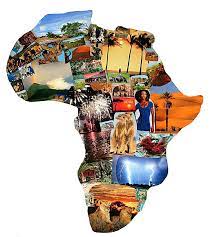Toward a Pan-African Federation: A Strategic Roadmap
The aspiration for a unified Africa, often envisioned as a "United States of Africa," represents a powerful expression of Pan-Africanism – the ideology promoting the solidarity and unity of all people of African descent. This concept, grounded in the historical precedents of collaborative African civilizations, necessitates a comprehensive strategic approach for its realization. This roadmap outlines fifteen key steps, leveraging relevant political science, economic, and sociological theories, to guide this transformative process.
The creation of such a federation requires a multifaceted approach, integrating economic, political, and socio-cultural dimensions. The following steps provide a framework for achieving this ambitious goal. We will explore the application of relevant theories and models throughout this analysis.
- Establishing a Robust Economic Foundation: Economic integration is paramount. The application of neo-functionalism, highlighting the spillover effects of initial integration efforts into broader areas, suggests that starting with initiatives like the African Continental Free Trade Area (AfCFTA) is crucial. The AfCFTA aims to create a single continental market, boosting intra-African trade and attracting foreign direct investment. This economic synergy, akin to the European Union's model, will lay the foundation for political integration.
- Building a Single African Market: A unified currency, inspired by the theory of optimal currency areas, would further simplify economic transactions and reduce exchange rate volatility, thus encouraging increased trade and investment. This approach requires careful consideration of macroeconomic convergence criteria, as seen in the Eurozone’s experience.
- Facilitating Free Movement of People: Implementing a continent-wide passport system, informed by principles of free movement and open borders, enhances intercultural exchange and strengthens the sense of shared identity. This resonates with the concept of transnationalism, recognizing the growing interconnectedness of African communities.
- Strengthening Pan-African Institutions: Reinforcing the African Union's role, guided by principles of regional integration, is paramount. The AU can serve as the primary coordinating body, fostering cooperation and resolving disputes using mechanisms such as conflict mediation and peacekeeping, mirroring successful models of international organizations.
- Promoting Peaceful Conflict Resolution: The application of conflict resolution theories, such as the peacebuilding paradigm, is vital. Establishing effective conflict prevention and resolution mechanisms, including diplomatic initiatives and addressing the root causes of conflict, is crucial for maintaining a stable and unified political environment.
- Fostering Political Cooperation and Harmonization: Effective political cooperation, based on principles of federalism and subsidiarity, involves delegating certain powers to a central authority while preserving the autonomy of member states. This balance is crucial to address shared challenges collectively while maintaining a degree of local control.
- Investing in Education and Capacity Building: A well-informed populace is essential for successful integration. Applying theories of human capital development, significant investments in education and public awareness campaigns will empower citizens with the knowledge and skills necessary for participating in the new federation.
- Engaging African Youth: Actively engaging and empowering African youth, leveraging concepts from youth development and participatory governance, is vital. Their inclusion ensures that the vision reflects the needs and aspirations of future generations.
- Celebrating and Leveraging Cultural Diversity: Recognizing and celebrating the continent's rich cultural diversity, guided by principles of multiculturalism, is key to creating a vibrant and inclusive society. This promotes social cohesion and avoids potential tensions stemming from cultural differences.
- Cultivating Transformational Leadership: Developing strong, visionary leadership committed to Pan-Africanism and effective governance, informed by public choice theory, is paramount. This necessitates mechanisms for promoting good governance, transparency, and accountability.
- Harnessing Technological Advancements: Leveraging technology, guided by principles of digital inclusion, can bridge geographical barriers, improving communication and information sharing across the continent. This addresses the challenges of connectivity and fosters a sense of unity.
- Prioritizing Locally Developed Solutions: Adopting a bottom-up approach, focusing on locally developed solutions and fostering self-reliance, promotes sustainability and reduces dependency on external actors. This resonates with the principles of endogenous development and community-based initiatives.
- Learning from Other Federations: Drawing lessons from the successes and failures of other federations, such as the European Union or the United States, and adapting them to Africa’s unique context, provides valuable insights for policymaking. Comparative federalism offers a rich source of information and best practices.
- Building a Shared Vision: Establishing a collective vision, grounded in shared goals and aspirations, is crucial. This requires extensive consultations with stakeholders, including civil society organizations, governments, and citizens, promoting a sense of ownership and collective responsibility.
- Promoting Sustainable Development: Integrating sustainable development goals into the federation’s policies ensures long-term prosperity and addresses environmental challenges. This incorporates principles of ecological modernization and ensures that the vision encompasses environmental sustainability.
Conclusions and Recommendations: The creation of a Pan-African Federation is a complex yet achievable undertaking. Success hinges on a multi-pronged strategy addressing economic, political, and socio-cultural dimensions. Key recommendations include prioritizing economic integration through the AfCFTA, strengthening the African Union's role, investing in education and youth engagement, and fostering peaceful conflict resolution. The federation's long-term viability depends on inclusive governance, promoting sustainable development, and celebrating cultural diversity. Further research should focus on comparative case studies of successful federations, exploring optimal institutional designs and addressing the challenges of political and economic disparity across African nations. This initiative’s success has wide-ranging implications for Africa’s economic growth, political stability, and global influence. It holds the potential to unlock the continent’s immense human and natural resources, fostering a new era of prosperity and cooperation.
Reader Pool: Considering the complexities outlined in this roadmap, what are the most critical challenges to achieving a Pan-African Federation, and what innovative strategies can be employed to overcome them?



